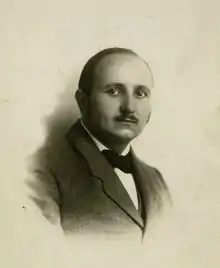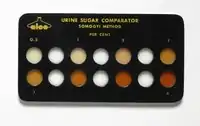Michael Somogyi
Dr. Michael Somogyi (March 7, 1883 – July 21, 1971) was a Hungarian-American professor of biochemistry at Washington University and the Jewish Hospital of St. Louis. He prepared the first insulin treatment given to a child with diabetes in the USA in October 1922.[1][2] Somogyi later showed that excessive insulin makes diabetes unstable in the Chronic Somogyi rebound to which he gave his name.
Michael Somogyi | |
|---|---|
Somogyi Mihály | |
 | |
| Born | March 7, 1883 |
| Died | July 21, 1971 (aged 88) |
| Nationality | Hungarian |
| Alma mater | University of Budapest |
| Known for | Somogyi effect |
Career
Michael Somogyi was born on March 7, 1883 in the village of Zsámánd in Hungary, (today Reinersdorf, part of Heiligenbrunn, Austria). He graduated in chemical engineering from the University of Budapest in 1905.[3]
After an additional year as an assistant in biochemistry, Somogyi went to the United States, where he eventually found a position as an assistant in biochemistry at Cornell University (1906–1908). He returned to Budapest where he worked at the Municipal Laboratory for the next decade. In 1914, he received his Ph.D. from the University of Budapest, submitting a dissertation on catalytic hydrogenation. During World War I he was in charge of providing food to the destitute.[4][5]
Somogyi was invited to return to the United States by Philip A. Shaffer, whom he had known at Cornell. In 1922 Somogyi became an instructor in biochemistry at Washington University Medical School, St. Louis, Missouri. There Somogyi worked with Shaffer and Edward Adelbert Doisy on insulin preparation and insulin's use in the treatment of diabetes. In 1926, Somogyi became the first biochemist on the staff of the new Jewish Hospital of St. Louis where he worked closely with physicians. He directed the hospital's clinical laboratory until he retired in 1957.[4]
Research
Insulin was discovered in 1921, by Frederick G. Banting, Charles Herbert Best and John James Rickard Macleod at the University of Toronto.[6] At a time when most child diabetics lived no more than months or a few years, insulin offered the hope of extending lives.[7] Somogyi worked with Philip A. Shaffer and Edward Adelbert Doisy on insulin preparation and insulin's use in the treatment of diabetes. He developed a method for extracting insulin from the pancreases of dogs. In 1922 doctors treated the first diabetic American child, a baby boy, with Somogyi’s insulin.[5][8]
Somogyi also developed a quicker, less expensive method for screening for diabetes, using sodium carbonate, urine, and heat. This led to the development of popular tests, including several varieties of urine sugar comparator from the Aloe Company of Saint Louis, Missouri. Urine Sugar Test kits were also produced by Eli Lilly & Company.[1]
 Paper Somogyi Urine sugar test, c. 1930–1950
Paper Somogyi Urine sugar test, c. 1930–1950 Wooden Somogyi Urine sugar comparator, c. 1930–1950
Wooden Somogyi Urine sugar comparator, c. 1930–1950 Plastic Somogyi Urine sugar comparator, c. 1930–1950
Plastic Somogyi Urine sugar comparator, c. 1930–1950
In 1938 Somogyi published findings showing that excessive insulin can make diabetes management unstable and increase the difficulty of treatment.[9] The Chronic Somogyi rebound, a form of post-hypoglycemic hyperglycemia that Somogyi theorized could occur as a defensive mechanism, is named for him. It can be confused with the Dawn phenomenon and whether or not Somogyi's theory is actuallly correct is still contested.[10]
In 1949, Somogyi argued against the use of high doses of insulin on the grounds that it was a potentially dangerous form of treatment. He also argued that many diabetic patients could successfully manage their conditions through a combination of diet and weight loss.[5]
In 1969, Michael Somogyi suffered a stroke. He died on 21 July 1971.[4]
References
- Jentile, Crysta (2010). "Taking Control". Distillations. 28 (3). Retrieved 26 March 2018.
- Michael Somogyi (www.whonamedit.com)
- Finding Aid to Photographs from the Dr. Michael Somogyi Collection, 1912-1971 (bulk 1950s) at the Science History Institute (For full finding aid, click on 'Dr. Michael Somogyi Collection Finding Aid'.)
- Walker, Harvey (1 November 1971). "Michael Somogyi, Ph.D. 1883-1971". Clinical Chemistry. 17 (11): 1138. doi:10.1093/clinchem/17.11.1138. PMID 4941418. Retrieved 21 April 2020.
- Walker, Harvey (April 1972). "Obituary-Michael Somogyi 1883–1971". Carbohydrate Research. 21 (3): 337–338. doi:10.1016/s0008-6215(00)84913-7. PMID 4559164.
- "Frederick Grant Banting". Library and Archives Canada. February 24, 2015. Retrieved April 21, 2020.
- Mazur, Allan (11 March 2011). "Why were "starvation diets" promoted for diabetes in the pre-insulin period?". Nutrition Journal. 10 (1): 23. doi:10.1186/1475-2891-10-23. PMC 3062586. PMID 21396115.
- Roberts, Jacob (2015). "Sickening sweet". Distillations. 1 (4): 12–15. Retrieved 20 March 2018.
- Somogyi, M; Kirstein, M (1938). "Insulin as a cause of extreme hyperglycemia and instability". Weekly Bulletin of the St Louis Medical Society. 32: 498–510. hdl:2027/uc1.$b721522. OCLC 11637296.
(As of 2011-05-28, the electronic text is not open access). - "Somogyi Phenomenon – Rebound Hyperglycemia". Diabetes.co.uk. 15 January 2019. Retrieved 21 April 2020.
External links
- Finding Aid to The Dr. Michael Somogyi Collection, 1912–1979 (bulk 1924–1970) at the Science History Institute (For full finding aid, click on 'Dr. Michael Somogyi Collection Finding Aid'.)
- Finding Aid to Photographs from the Dr. Michael Somogyi Collection, 1912–1971 (bulk 1950s) at the Science History Institute (For full finding aid, click on 'Dr. Michael Somogyi Collection Finding Aid'.)
